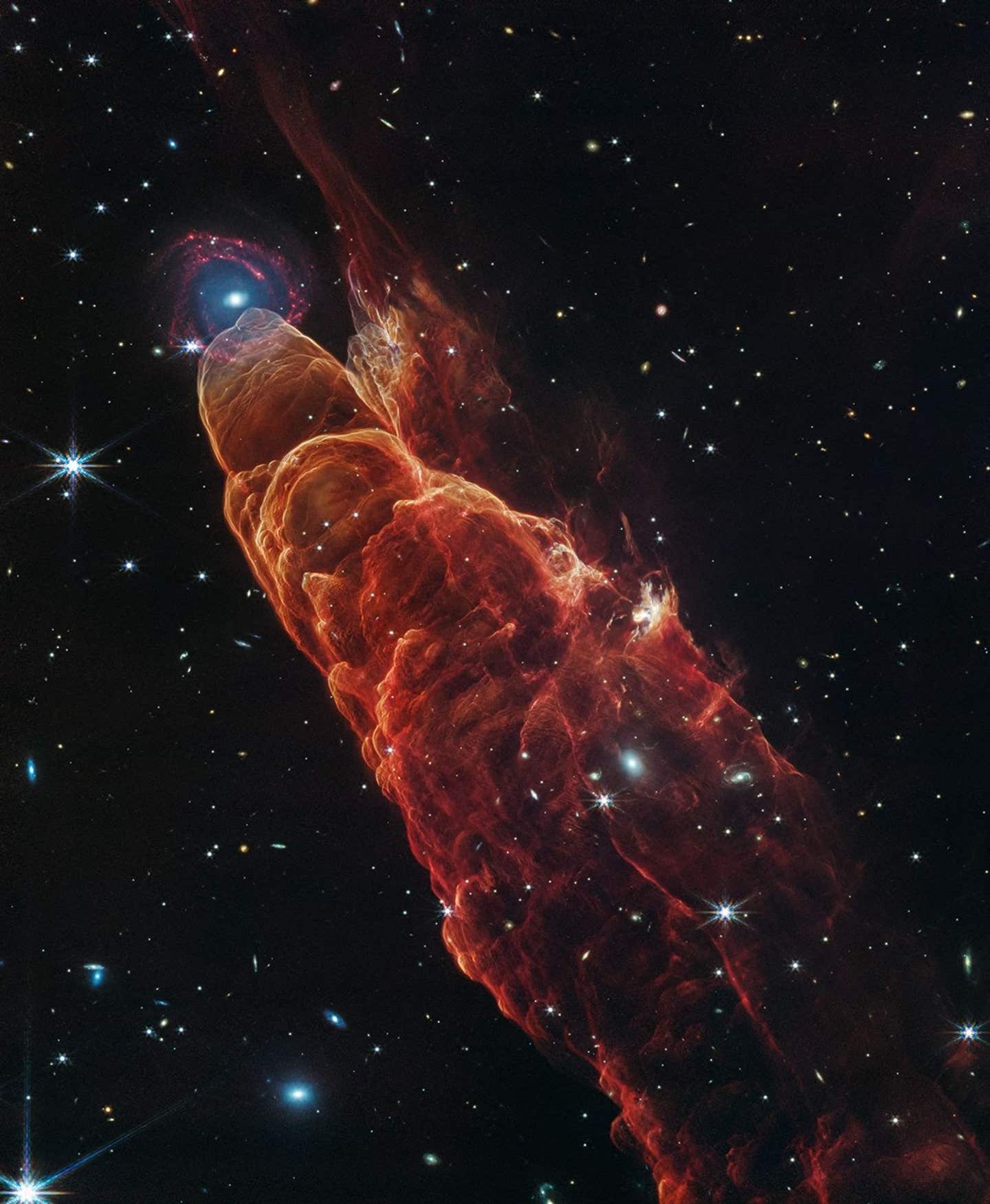NASA’s Webb Telescope Reveals ‘Cosmic Tornado’ in Action
Webb’s stunning image of HH 49/50 captures a star’s jet aligned with a distant galaxy, revealing new insights into star formation.

NASA’s James Webb Space Telescope observed Herbig-Haro 49/50, an outflow from a nearby still-forming star, in high-resolution near- and mid-infrared light. (CREDIT: NASA, ESA, CSA, STScI)
A newborn star, a blast of glowing gas, and a distant spiral galaxy — all caught in one stunning snapshot by the James Webb Space Telescope. This rare cosmic overlap forms a swirling, colorful image that blends science with art, and it’s helping scientists learn more about how stars are born.
About 625 light-years from Earth, deep within a region of space called the Chamaeleon I Cloud complex, a young star is growing. This area, one of the closest stellar nurseries to us, is full of dust and gas — the raw material for forming new stars.
Many of these young stars are about the same size as our own Sun. Scientists believe the environment here might look a lot like the one where our solar system formed billions of years ago.
In this active region of space, a young object named Herbig-Haro 49/50, or HH 49/50, is lighting up the sky. It isn’t a star itself, but a dramatic outflow of glowing gas created by one. And thanks to a fortunate alignment, this stream of heated material appears to line up with a beautiful spiral galaxy in the background, creating a visual that’s both rare and rich in scientific value.
Glowing Outflows from Young Stars
The eye-catching light show from HH 49/50 is caused by jets of charged particles. These jets are shot out by a growing star — or protostar — as it pulls in gas from a surrounding disk. The material doesn’t all make it onto the star. Some of it is funneled along strong magnetic fields and blasted into space at extreme speeds.
When this ejected material slams into clouds of dust and gas, it forms shock waves. These waves heat the gas, which then cools by giving off light. The result is a Herbig-Haro object — a glowing structure that can stretch across light-years of space.
The star behind this outburst is likely a young protostar known as Cederblad 110 IRS4. It’s located about 1.5 light-years away from the center of the HH 49/50 structure and belongs to a group called Class I protostars. These are stars in the early stages of life, just tens of thousands to a million years old. They’re still pulling in mass and surrounded by disks of gas and dust. Many scientists think stars like this go through a period of growth where some gas is shot out in jets while the rest helps form planets and moons.
Related Stories
Webb’s recent observations confirmed this behavior. The telescope’s near-infrared and mid-infrared cameras (NIRCam and MIRI) picked up glowing hydrogen and carbon monoxide molecules, as well as energized grains of dust, showing up as orange and red in the image. These materials glow because they’ve been heated by the jet as it collides with its surroundings. The result is a textured, frothy look that has earned HH 49/50 the nickname “Cosmic Tornado.”
Clues in the Curves
One of the most fascinating parts of this image is the series of arcs. These curves, made of glowing gas, look like ripples or waves and point back toward the protostar that launched the jet. The arcs help scientists trace the origin of the outflow and better understand how the jet is moving.
However, not every arc follows the same path. One strange outcrop near the top of the image doesn't line up with the others. It could be a second outflow from a different star, or it might be part of the same jet that's slowly shifting its aim over time — a motion known as precession. Another theory suggests the outflow is breaking apart, leading to more chaotic structures.
“Webb’s observations probe details on small spatial scales that will help astronomers to model the properties of the jet and understand how it is affecting the surrounding material,” NASA scientists said in their release of the image.
The direction and shape of these arcs are especially helpful. They let researchers figure out not only where the outflow started, but also how the jet interacts with the gas and dust around it. This is key to understanding how stars grow and change their environment.
The Surprise Spiral Galaxy
The beauty of the image doesn’t end with the Herbig-Haro object. At the very tip of the jet, you’ll see a fuzzy, multi-colored spiral galaxy that looks like it could be part of the outflow. It’s not.
This galaxy is much farther away and just happens to sit in the same line of sight as HH 49/50. The alignment is purely by chance, but it makes for a jaw-dropping view. What once looked like a blurry light in older telescope images is now revealed in full detail by Webb.
The spiral galaxy is seen face-on, giving a clear look at its central bulge and swirling arms. The bright blue center shows clusters of older stars, while the reddish clumps in the arms reveal places where new stars are forming. These clumps also contain warm dust and pockets of gas, the same ingredients found in galaxies much closer to us. Webb even detected bubbles in the dusty arms — signs that earlier generations of stars have blown material outward, shaping the galaxy's form.
Hints of side lobes coming off the central bulge suggest that this could be a barred spiral galaxy, a type of galaxy with a central bar-shaped structure made of stars. These features are often connected to how gas flows inside galaxies and may help funnel material toward the center, where stars are born.
This accidental overlap of two completely unrelated objects — a newborn star’s fiery jet and a distant spiral galaxy — gives scientists a rich opportunity to study both at once. Over time, as the HH 49/50 outflow keeps expanding, it will appear to move across the sky and could end up covering more of the galaxy behind it.
A Glimpse of the Past and the Future
The chance alignment of HH 49/50 and the distant galaxy is like catching lightning in a bottle. It combines the drama of star birth with the quiet beauty of an ancient galaxy, frozen in a moment of cosmic coincidence.
In 2006, NASA's Spitzer Space Telescope captured a blurrier version of the same scene. The HH 49/50 outflow earned its nickname "Cosmic Tornado" thanks to its twisting, storm-like appearance. But back then, scientists couldn’t tell what the fuzzy spot at the end of the outflow really was. With Webb’s sharper imaging, that mystery has now been solved.
Spitzer also helped measure how fast HH 49/50 is moving. The outflow is racing away from Earth at speeds between 60 and 190 miles per second — or about 100 to 300 kilometers per second. That’s fast enough to cross the continental United States in under a minute.
As Webb continues to scan the skies, more images like this will likely come to light. Each one tells a story about the birth of stars, the power of jets, and the changing shapes of galaxies. For now, HH 49/50 is a snapshot of energy and movement frozen in space, a picture of chaos and structure woven together by the hand of chance.
Note: The article above provided above by The Brighter Side of News.
Like these kind of feel good stories? Get The Brighter Side of News' newsletter.
Joshua Shavit
Science & Technology Writer | AI and Robotics Reporter
Joshua Shavit is a Los Angeles-based science and technology writer with a passion for exploring the breakthroughs shaping the future. As a contributor to The Brighter Side of News, he focuses on positive and transformative advancements in AI, technology, physics, engineering, robotics and space science. Joshua is currently working towards a Bachelor of Science in Business Administration at the University of California, Berkeley. He combines his academic background with a talent for storytelling, making complex scientific discoveries engaging and accessible. His work highlights the innovators behind the ideas, bringing readers closer to the people driving progress.



